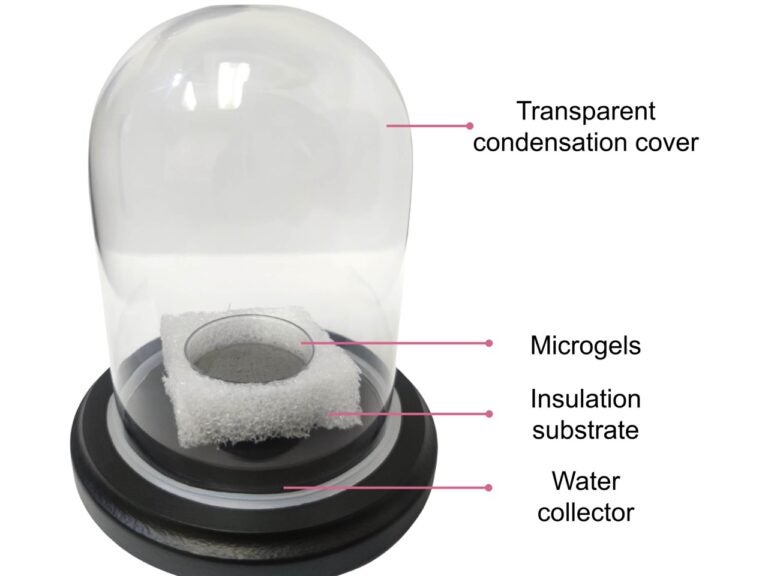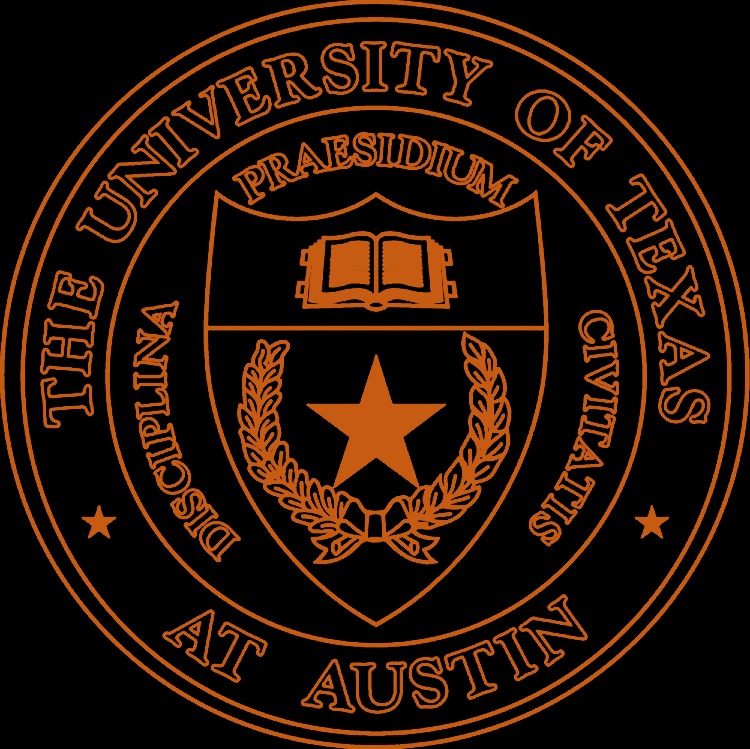From The University of Texas-Austin
9.11.23
Nat Levy | Cockrell School of Engineering
nat.levy@utexas.edu
For significant portions of the globe faced with water shortage problems, a beacon of hope may be on the way: the ability to easily turn hot air into drinking water.

UTexas.
For the past few years, researchers at The University of Texas at Austin have focused on the moisture present in the air as a potential source of drinking water for drought-stressed populations. In new research published in the PNAS [below], they reached a significant breakthrough in their efforts to create drinkable water out of thin air: a molecularly engineered hydrogel that can create clean water using just the energy from sunlight.
The researchers were able to pull water out of the atmosphere and make it drinkable using solar energy, in conditions as low as 104 degrees, aligning with summer weather in Texas and other parts of the world. That means people in places with excess heat and minimal access to clean water could someday simply place a device outside, and it would make water for them, with no additional effort necessary.
“With our new hydrogel, we’re not just pulling water out of thin air. We’re doing it extremely fast and without consuming too much energy,” said Guihua Yu, a materials science and engineering professor in the Cockrell School of Engineering’s Walker Department of Mechanical Engineering and Texas Materials Institute. “What’s really fascinating about our hydrogel is how it releases water. Think about a hot Texas summer — we could just use our temperatures’ natural ups and downs, no need to crank up any heaters.”
The device can produce between 3.5 and 7 kilograms of water per kilogram of gel materials, depending on humidity conditions.

UTexas.
A significant feature of this research is the hydrogel’s adaptability into microparticles called “microgels.” These microgels unlock the speed and efficiency improvements that bring this device much closer to reality.
“By transforming the hydrogel into micro-sized particles, we can make the water capture and release ultrafast,” said Weixin Guan, a graduate student in Yu’s lab and one of the leaders of the research. “This offers a new, highly efficient type of sorbents that can significantly enhance the water production by multiple daily cycling.”
The researchers are pursuing additional improvements to the technology, with an eye toward transforming it into a commercial product. One focus area is optimizing the engineering of the microgels to further improve efficiency.
Scaling up is an important next step. The researchers aim to translate their work into tangible and scalable solutions that can be used worldwide as a low-cost, portable method of creating clean drinking water. This could be life-changing for countries such as Ethiopia, where almost 60% of the population lacks basic access to clean water.
“We developed this device with the ultimate goal to be available to people around the world who need quick and consistent access to clean, drinkable water, particularly in those arid areas,” said Yaxuan Zhao, a graduate student in Yu’s lab.”
The team is working on other versions of the device made from organic materials, which would reduce costs for mass production. This transition to more commercially viable designs comes with its own challenges in scaling production of the sorbent that allows moisture absorption and in maintaining durability for the product’s lifespan. Research is also focused on making the devices portable for various application scenarios.
This project is supported by the Norman Hackerman Award in Chemical Research from The Welch Foundation and the Camille Dreyfus Teacher-Scholar Award.
See the full article here .
Comments are invited and will be appreciated, especially if the reader finds any errors which I can correct. Use “Reply” at the bottom of the post.
five-ways-keep-your-child-safe-school-shootings
Please help promote STEM in your local schools.

The University of Texas-Austin is a public research university in Austin, Texas and the flagship institution of the University of Texas System. Founded in 1883, the University of Texas was inducted into the Association of American Universities in 1929, becoming only the third university in the American South to be elected. The institution has the nation’s seventh-largest single-campus enrollment, with over 50,000 undergraduate and graduate students and over 24,000 faculty and staff.
A Public Ivy, it is a major center for academic research. The university houses seven museums and seventeen libraries, including the LBJ Presidential Library and the Blanton Museum of Art, and operates various auxiliary research facilities, such as the J. J. Pickle Research Campus and the McDonald Observatory. As of November 2020, 13 Nobel Prize winners, four Pulitzer Prize winners, two Turing Award winners, two Fields medalists, two Wolf Prize winners, and two Abel prize winners have been affiliated with the school as alumni, faculty members or researchers. The university has also been affiliated with three Primetime Emmy Award winners, and has produced a total of 143 Olympic medalists.
Student-athletes compete as the Texas Longhorns and are members of the Big 12 Conference. Its Longhorn Network is the only sports network featuring the college sports of a single university. The Longhorns have won four NCAA Division I National Football Championships, six NCAA Division I National Baseball Championships, thirteen NCAA Division I National Men’s Swimming and Diving Championships, and has claimed more titles in men’s and women’s sports than any other school in the Big 12 since the league was founded in 1996.
Establishment
The first mention of a public university in Texas can be traced to the 1827 constitution for the Mexican state of Coahuila y Tejas. Although Title 6, Article 217 of the Constitution promised to establish public education in the arts and sciences, no action was taken by the Mexican government. After Texas obtained its independence from Mexico in 1836, the Texas Congress adopted the Constitution of the Republic, which, under Section 5 of its General Provisions, stated “It shall be the duty of Congress, as soon as circumstances will permit, to provide, by law, a general system of education.”
On April 18, 1838, “An Act to Establish the University of Texas” was referred to a special committee of the Texas Congress, but was not reported back for further action. On January 26, 1839, the Texas Congress agreed to set aside fifty leagues of land—approximately 288,000 acres (117,000 ha)—towards the establishment of a publicly funded university. In addition, 40 acres (16 ha) in the new capital of Austin were reserved and designated “College Hill”. (The term “Forty Acres” is colloquially used to refer to the University as a whole. The original 40 acres is the area from Guadalupe to Speedway and 21st Street to 24th Street.)
In 1845, Texas was annexed into the United States. The state’s Constitution of 1845 failed to mention higher education. On February 11, 1858, the Seventh Texas Legislature approved O.B. 102, an act to establish the University of Texas, which set aside $100,000 in United States bonds toward construction of the state’s first publicly funded university (the $100,000 was an allocation from the $10 million the state received pursuant to the Compromise of 1850 and Texas’s relinquishing claims to lands outside its present boundaries). The legislature also designated land reserved for the encouragement of railroad construction toward the university’s endowment. On January 31, 1860, the state legislature, wanting to avoid raising taxes, passed an act authorizing the money set aside for the University of Texas to be used for frontier defense in west Texas to protect settlers from Indian attacks.
Texas’s secession from the Union and the American Civil War delayed repayment of the borrowed monies. At the end of the Civil War in 1865, The University of Texas’s endowment was just over $16,000 in warrants and nothing substantive had been done to organize the university’s operations. This effort to establish a University was again mandated by Article 7, Section 10 of the Texas Constitution of 1876 which directed the legislature to “establish, organize and provide for the maintenance, support and direction of a university of the first class, to be located by a vote of the people of this State, and styled “The University of Texas”.
Additionally, Article 7, Section 11 of the 1876 Constitution established the Permanent University Fund, a sovereign wealth fund managed by the Board of Regents of the University of Texas and dedicated to the maintenance of the university. Because some state legislators perceived an extravagance in the construction of academic buildings of other universities, Article 7, Section 14 of the Constitution expressly prohibited the legislature from using the state’s general revenue to fund construction of university buildings. Funds for constructing university buildings had to come from the university’s endowment or from private gifts to the university, but the university’s operating expenses could come from the state’s general revenues.
The 1876 Constitution also revoked the endowment of the railroad lands of the Act of 1858, but dedicated 1,000,000 acres (400,000 ha) of land, along with other property appropriated for the university, to the Permanent University Fund. This was greatly to the detriment of the university as the lands the Constitution of 1876 granted the university represented less than 5% of the value of the lands granted to the university under the Act of 1858 (the lands close to the railroads were quite valuable, while the lands granted the university were in far west Texas, distant from sources of transportation and water). The more valuable lands reverted to the fund to support general education in the state (the Special School Fund).
On April 10, 1883, the legislature supplemented the Permanent University Fund with another 1,000,000 acres (400,000 ha) of land in west Texas granted to the Texas and Pacific Railroad but returned to the state as seemingly too worthless to even survey. The legislature additionally appropriated $256,272.57 to repay the funds taken from the university in 1860 to pay for frontier defense and for transfers to the state’s General Fund in 1861 and 1862. The 1883 grant of land increased the land in the Permanent University Fund to almost 2.2 million acres. Under the Act of 1858, the university was entitled to just over 1,000 acres (400 ha) of land for every mile of railroad built in the state. Had the 1876 Constitution not revoked the original 1858 grant of land, by 1883, the university lands would have totaled 3.2 million acres, so the 1883 grant was to restore lands taken from the university by the 1876 Constitution, not an act of munificence.
On March 30, 1881, the legislature set forth the university’s structure and organization and called for an election to establish its location. By popular election on September 6, 1881, Austin (with 30,913 votes) was chosen as the site. Galveston, having come in second in the election (with 20,741 votes), was designated the location of the medical department (Houston was third with 12,586 votes). On November 17, 1882, on the original “College Hill,” an official ceremony commemorated the laying of the cornerstone of the Old Main building. University President Ashbel Smith, presiding over the ceremony, prophetically proclaimed “Texas holds embedded in its earth rocks and minerals which now lie idle because unknown, resources of incalculable industrial utility, of wealth and power. Smite the earth, smite the rocks with the rod of knowledge and fountains of unstinted wealth will gush forth.” The University of Texas officially opened its doors on September 15, 1883.
Expansion and growth
In 1890, George Washington Brackenridge donated $18,000 for the construction of a three-story brick mess hall known as Brackenridge Hall (affectionately known as “B.Hall”), one of the university’s most storied buildings and one that played an important place in university life until its demolition in 1952.
The old Victorian-Gothic Main Building served as the central point of the campus’s 40-acre (16 ha) site, and was used for nearly all purposes. But by the 1930s, discussions arose about the need for new library space, and the Main Building was razed in 1934 over the objections of many students and faculty. The modern-day tower and Main Building were constructed in its place.
In 1910, George Washington Brackenridge again displayed his philanthropy, this time donating 500 acres (200 ha) on the Colorado River to the university. A vote by the regents to move the campus to the donated land was met with outrage, and the land has only been used for auxiliary purposes such as graduate student housing. Part of the tract was sold in the late-1990s for luxury housing, and there are controversial proposals to sell the remainder of the tract. The Brackenridge Field Laboratory was established on 82 acres (33 ha) of the land in 1967.
In 1916, Gov. James E. Ferguson became involved in a serious quarrel with the University of Texas. The controversy grew out of the board of regents’ refusal to remove certain faculty members whom the governor found objectionable. When Ferguson found he could not have his way, he vetoed practically the entire appropriation for the university. Without sufficient funding, the university would have been forced to close its doors. In the middle of the controversy, Ferguson’s critics brought to light a number of irregularities on the part of the governor. Eventually, the Texas House of Representatives prepared 21 charges against Ferguson, and the Senate convicted him on 10 of them, including misapplication of public funds and receiving $156,000 from an unnamed source. The Texas Senate removed Ferguson as governor and declared him ineligible to hold office.
In 1921, the legislature appropriated $1.35 million for the purchase of land next to the main campus. However, expansion was hampered by the restriction against using state revenues to fund construction of university buildings as set forth in Article 7, Section 14 of the Constitution. With the completion of Santa Rita No. 1 well and the discovery of oil on university-owned lands in 1923, the university added significantly to its Permanent University Fund. The additional income from Permanent University Fund investments allowed for bond issues in 1931 and 1947, which allowed the legislature to address funding for the university along with the Agricultural and Mechanical College (now known as Texas A&M University). With sufficient funds to finance construction on both campuses, on April 8, 1931, the Forty Second Legislature passed H.B. 368. which dedicated the Agricultural and Mechanical College a 1/3 interest in the Available University Fund, the annual income from Permanent University Fund investments.
The University of Texas was inducted into The Association of American Universities in 1929. During World War II, the University of Texas was one of 131 colleges and universities nationally that took part in the V-12 Navy College Training Program which offered students a path to a Navy commission.
In 1950, following Sweatt v. Painter, the University of Texas was the first major university in the South to accept an African-American student. John S. Chase went on to become the first licensed African-American architect in Texas.
In the fall of 1956, the first black students entered the university’s undergraduate class. Black students were permitted to live in campus dorms, but were barred from campus cafeterias. The University of Texas integrated its facilities and desegregated its dorms in 1965. UT, which had had an open admissions policy, adopted standardized testing for admissions in the mid-1950s at least in part as a conscious strategy to minimize the number of Black undergraduates, given that they were no longer able to simply bar their entry after the Brown decision.
Following growth in enrollment after World War II, the university unveiled an ambitious master plan in 1960 designed for “10 years of growth” that was intended to “boost the University of Texas into the ranks of the top state universities in the nation.” In 1965, the Texas Legislature granted the university Board of Regents to use eminent domain to purchase additional properties surrounding the original 40 acres (160,000 m^2). The university began buying parcels of land to the north, south, and east of the existing campus, particularly in the Blackland neighborhood to the east and the Brackenridge tract to the southeast, in hopes of using the land to relocate the university’s intramural fields, baseball field, tennis courts, and parking lots.
On March 6, 1967, the Sixtieth Texas Legislature changed the university’s official name from “The University of Texas” to “The University of Texas at Austin” to reflect the growth of the University of Texas System.
Recent history
The first presidential library on a university campus was dedicated on May 22, 1971, with former President Johnson, Lady Bird Johnson and then-President Richard Nixon in attendance. Constructed on the eastern side of the main campus, the Lyndon Baines Johnson Library and Museum is one of 13 presidential libraries administered by the National Archives and Records Administration.
A statue of Martin Luther King Jr. was unveiled on campus in 1999 and subsequently vandalized. By 2004, John Butler, a professor at the McCombs School of Business suggested moving it to Morehouse College, a historically black college, “a place where he is loved”.
The University of Texas-Austin has experienced a wave of new construction recently with several significant buildings. On April 30, 2006, the school opened the Blanton Museum of Art. In August 2008, the AT&T Executive Education and Conference Center opened, with the hotel and conference center forming part of a new gateway to the university. Also in 2008, Darrell K Royal-Texas Memorial Stadium was expanded to a seating capacity of 100,119, making it the largest stadium (by capacity) in the state of Texas at the time.
The University of Texas-Austin is the home of
The Texas Advanced Computing Center
On January 19, 2011, the university announced the creation of a 24-hour television network in partnership with ESPN, dubbed the Longhorn Network. ESPN agreed to pay a $300 million guaranteed rights fee over 20 years to the university and to IMG College, the school’s multimedia rights partner. The network covers the university’s intercollegiate athletics, music, cultural arts, and academics programs. The channel first aired in September 2011.


